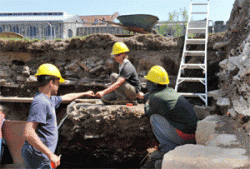- 09 JUIN
- ISRAËL –  Jerusalem - One of the most prominent Israeli archaeologists declared today that remains from the First and Second Jewish Temple period – including the Second Temple itself – lie underneath the Temple Mount surface, just waiting to be excavated. Dr. Eilat Mazar of Hebrew University accused the site's Islamic custodians of destroying Jewish artifacts while attempting to turn the Temple Mount into a "giant mosque." Mazar said she is "absolutely sure" remains from the First and Second Temple periods, including "the Second Temple itself," as well as later remains from the Byzantine and early Islamic periods, are just under the surface of the Temple Mount. Continued Mazar: "I am absolutely sure, in light of my very rich experience excavating Jerusalem for 30 years now, all these remains are waiting to be revealed. And if it can't be done nowadays because of all kinds of sensitivities, at least we should take care that it won't be ruined for future excavations when time comes." Mazar heads the excavation department at the City of David, an archaeological village at the foot of the Temple Mount said to be the place where King David built his palace and established his capital. Mazar has led digs that discovered multiple Temple-era remains, including a tunnel used by the Israelites to conquer Jerusalem, as well as the world's largest ritual bath.
Jerusalem - One of the most prominent Israeli archaeologists declared today that remains from the First and Second Jewish Temple period – including the Second Temple itself – lie underneath the Temple Mount surface, just waiting to be excavated. Dr. Eilat Mazar of Hebrew University accused the site's Islamic custodians of destroying Jewish artifacts while attempting to turn the Temple Mount into a "giant mosque." Mazar said she is "absolutely sure" remains from the First and Second Temple periods, including "the Second Temple itself," as well as later remains from the Byzantine and early Islamic periods, are just under the surface of the Temple Mount. Continued Mazar: "I am absolutely sure, in light of my very rich experience excavating Jerusalem for 30 years now, all these remains are waiting to be revealed. And if it can't be done nowadays because of all kinds of sensitivities, at least we should take care that it won't be ruined for future excavations when time comes." Mazar heads the excavation department at the City of David, an archaeological village at the foot of the Temple Mount said to be the place where King David built his palace and established his capital. Mazar has led digs that discovered multiple Temple-era remains, including a tunnel used by the Israelites to conquer Jerusalem, as well as the world's largest ritual bath.
http://www.wnd.com/?pageId=307697
- MEXIQUE – Monterrey - Archeologists have uncovered the remains of U.S. soldiers probably killed in an 1846 Mexican-American War battle, some with bullet wounds and with many of their bones intact. Found at a construction site and encrusted in the desert soil in Monterrey near the Texan border, the 10 sets of skeletal remains were discovered with buttons from uniforms, Mexico's National Institute of Anthropology said. The institute's archeologist leading the excavation, Araceli Rivera, said the height of the skeletons, ranging from 5 feet 7 inches to 5 feet 9 inches (1.70 to 1.75 meters), meant they were U.S. soldiers, who were taller than Mexicans then."They don't coincide with the average height of Mexicans from that period," the institute said. U.S. forces under the command of General Zachary Taylor took Monterrey on Sept. 23, 1846 after several days of fighting, an important victory in the Mexican-American War of 1846-1848. The conflict was sparked by the United States' annexation of Texas in 1845, which Mexico considered its own. Mexico eventually lost the war and ceded almost half of its territory to the United States -- including claims on Arizona, California, Nevada, New Mexico, Utah and parts of Colorado -- in a humiliation that still stings some Mexicans today. Some 367 Mexican soldiers and 120 U.S. troops were killed in the Battle of Monterrey, according to U.S. Army historians. The Mexican anthropology institute believes bodies of Mexican soldiers were quickly claimed by families and buried in cemeteries across the city.
http://in.reuters.com/article/2011/06/03/idINIndia-57491720110603
- USA – Arizona -Wildfires threaten archaeological sites. As the fire moves east toward New Mexico it enters the historically rich Gila and Apache-Sitgreaves national forests, where scientists estimate there are several thousand archeological sites. "That may be a low figure," said Jim Bradford, regional supervisory archeologist for the National Park Service. The sites, which are defined by the physical remains of human activity, can be anything from a scattering of spear points to a multistory cliff palace. Archeologists have evidence of 12,000 years of human history in the area.
http://www.latimes.com/news/nationworld/nation/la-na-arizona-fires-20110609,0,4031169.story
- CANADA –  Quebec - Le chantier-école de l’îlot des Palais n’a pas fini de livrer ses nombreux pans d’histoire aux étudiants en archéologie . Une entente avec la municipalité permet en effet aux étudiants d’explorer chaque été une portion de ce site qui constituait la porte d’entrée de la Nouvelle-France. «Sur des cartes, on a vu le dessin d’un bassin qui arrivait peut-être dans cette cour capable d’accueillir 300 petits bateaux à fond plat transportant des marchandises vers des navires ancrés au large, avance Allison Bain, professeure d’archéologie qui supervise la douzaine de stagiaires. Il faut savoir qu’au 17e siècle, la rivière Saint-Charles venait jusqu’à la rue qui borde maintenant la Maison de Lauberivière.» Pour l’instant, les étudiants ne sont pas encore arrivés au niveau de ce bassin potentiel. Leurs recherches ont permis de mettre au jour la cour du deuxième palais de l’intendant, le premier ayant brûlé lors de l’incendie du quartier Saint-Roch. Comme s’il s’agissait d’un millefeuille, ils ont d’abord découvert les gros pavés de la brasserie Boswell-Dow construite sur les ruines du palais, puis les blocs de schiste qui constituaient la dalle sur laquelle reposait la fondation de béton, avant d’accéder au remblai contenant plusieurs objets.
Quebec - Le chantier-école de l’îlot des Palais n’a pas fini de livrer ses nombreux pans d’histoire aux étudiants en archéologie . Une entente avec la municipalité permet en effet aux étudiants d’explorer chaque été une portion de ce site qui constituait la porte d’entrée de la Nouvelle-France. «Sur des cartes, on a vu le dessin d’un bassin qui arrivait peut-être dans cette cour capable d’accueillir 300 petits bateaux à fond plat transportant des marchandises vers des navires ancrés au large, avance Allison Bain, professeure d’archéologie qui supervise la douzaine de stagiaires. Il faut savoir qu’au 17e siècle, la rivière Saint-Charles venait jusqu’à la rue qui borde maintenant la Maison de Lauberivière.» Pour l’instant, les étudiants ne sont pas encore arrivés au niveau de ce bassin potentiel. Leurs recherches ont permis de mettre au jour la cour du deuxième palais de l’intendant, le premier ayant brûlé lors de l’incendie du quartier Saint-Roch. Comme s’il s’agissait d’un millefeuille, ils ont d’abord découvert les gros pavés de la brasserie Boswell-Dow construite sur les ruines du palais, puis les blocs de schiste qui constituaient la dalle sur laquelle reposait la fondation de béton, avant d’accéder au remblai contenant plusieurs objets.
http://www.aufil.ulaval.ca/articles/reconstituer-histoire-couche-par-couche-32862.html
- FRANCE – Le Gâvre - Mis au jour en 2008, l'alignement entièrement situé en forêt, serait à ce jour le plus long d'Europe : plus d'une centaine de pierres ont été identifiées sur plus d'un kilomètre de long. « On cherche encore la signification de ces alignements de pierres érigés par les hommes du néolithique », avoue Yves Kernaleguen, animateur de la section archéologie. « La seule chose dont on est quasiment certain, grâce à un tout nouveau système de datation expérimenté sur le site par des scientifiques, c'est que cet alignement a été érigé aux environs de 1 700 ans avant notre ère ».
http://www.ouest-france.fr/actu/actuLocale_-a-la-decouverte-des-megalithes-de-la-foret-samedi-_44062-avd-20110607-60642354_actuLocale.Htm
- ROUMANIE – Rosia Montana – Dans la région minière de Rosia Montana, une équipe franco-roumaine d’archéologues a découvert dans une mine une ancienne installation d’évacuation des eaux usées. Le système hydraulique a été réalisé au IIe siècle ap JC et il a été très bien conservé. « C’est la première fois depuis 1930 qu’un tel système est découvert dans une mine européenne », a remarqué Béatrice Cuet, la coordonnatrice des travaux.
http://www.roumanie.com/--A618.html
- IRLANDE - The archaeological find at the site of the Fr Mathew Hall, which is being renovated and extended to accommodate a new art gallery, was not the Connaught Tower as initially believed, but is a riverside or old quay wall. Archaeologists have not yet dated the structure, which is considered industrial archaeology, but work is ongoing in this regard. The wall will get a level of protection, which may mean that the foundations of the Fr Mathew Hall may have to be altered so that they go around the quay wall.
http://www.westmeathindependent.ie/news/roundup/articles/2011/06/08/4004821-archaeological-find-is-old-quay-wall/
- INDE – Jaipur - Nahargarh fort standing atop Aravali hill just above the Walled City of Jaipur is all set to get a facelift. Archaeology department has finally planned restoration work for the fort, which was once abode for nine queens of Sawai Jai Singh.
http://daily.bhaskar.com/article/RAJ-JPR-rs-2-2173213.html
